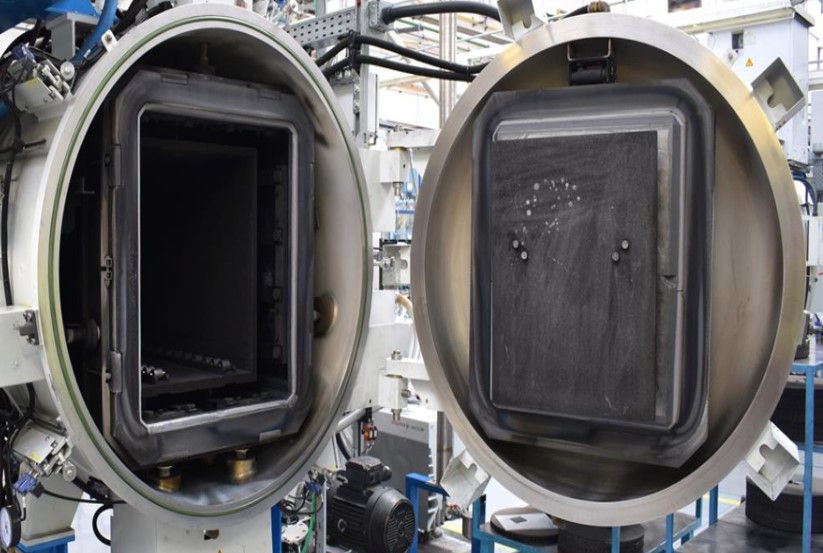
The main driver of business sustainability goals is to make an impact on the environment. Another benefit is the economic value of implementing sustainable actions. Can businesses save money, and protect the planet?
Sachin Pimpalnerkar, global segment manager for renewable energy at Sandvik, said the Sandvik Machining Solutions (SMS) has optimized two crucial toolmaking technologies to achieve those dual goals.
Most metal is machined with an insert that can withstand extreme heat and force, and so these tools are made of some of the world's hardest materials. Typically, an insert is made using 80 percent tungsten carbide, for its durability, and a metal matrix that binds the carbide grains together, where cobalt is the most common.
Sintering
One of the most energy-intensive steps in tool insert manufacturing is sintering. After metal powders are milled and then pressed into shape, the inserts are very fragile. At this stage, the inserts are fused, or sintered, into solid pieces.
Inserts can spend up to 13 hours in a sintering oven, at a temperature of approximately 1,500°C, where they are sintered into an extremely tough cemented carbide product.
Keeping furnaces in operation for many hours at a time consumes immense amounts of energy, but cutting corners and producing fragile inserts would be even more wasteful. Reducing energy consumption requires a reduction in cycle times without compromising product quality.
Research teams at Dormer Pramet, a cutting tool manufacturer and part of the Sandvik Group, did just that. Sintering cycle times were reduced by almost 100 minutes. To achieve this reduction, Dormer Pramet engineers worked with research and development specialists from Sandvik Materials Technology (SMT) in Pune, India, to redesign the gas flow passing through the charge of the sintering furnaces.
Dormer Pramet’s facility in Sumperk, Czech Republic, is the first to trial the new sintering process. Shorter sintering cycles also means that the facility can produce more parts while using the name amount of energy.
CVD coating
When machining ferrous materials such as cast iron or stainless steel, a coated insert is the favored tool of choice. Chemical vapor deposition (CVD) coating involves placing tools into a gas-filled chamber heated to 950 to 1100°C. The gases react inside the heated chamber, depositing a thin layer onto each tool that reinforces tool strength.
There are two common types of CVD heating. Cold wall CVD heats the contents of the chamber by passing current through the chamber itself, while its walls remain at room temperature. Hot wall CVD heats the chamber using an external power source and radiation from the chamber’s walls heats its contents. In this case, engineers were faced with another heating dilemma. High temperatures are key to effective CVD coating, but maintaining them is an energy intensive process.
To prevent heat from escaping CVD coating chambers, engineers adding insulation onto the furnace’s coating to trap heat inside the chamber has shortened the cycle times of CVD reactors, and is estimated to lower emissions by 25 tons every year.
Improved insulation also improves deposition conditions, meaning that inserts in the chamber can receive a more even coating to create stronger and more effective tools.
Combined, these two actions are calculated to not only reduce annual emissions by around 40 ton, but also save around 230,000 Euros ($269.334) every year. Sustainable action will always focus on environmental improvement, but by implementing simple changes, manufacturers may also enjoy the business benefits that process evaluation can bring.
For more information on Sandvik’s sustainability goals, click here. For information on the company’s products, visit Sandvik’s web page.
Related Glossary Terms
- chemical vapor deposition ( CVD)
chemical vapor deposition ( CVD)
High-temperature (1,000° C or higher), atmosphere-controlled process in which a chemical reaction is induced for the purpose of depositing a coating 2µm to 12µm thick on a tool’s surface. See coated tools; PVD, physical vapor deposition.
- chemical vapor deposition ( CVD)2
chemical vapor deposition ( CVD)
High-temperature (1,000° C or higher), atmosphere-controlled process in which a chemical reaction is induced for the purpose of depositing a coating 2µm to 12µm thick on a tool’s surface. See coated tools; PVD, physical vapor deposition.
- sintering
sintering
Bonding of adjacent surfaces in a mass of particles by molecular or atomic attraction on heating at high temperatures below the melting temperature of any constituent in the material. Sintering strengthens and increases the density of a powder mass and recrystallizes powder metals.
- tungsten carbide ( WC)
tungsten carbide ( WC)
Intermetallic compound consisting of equal parts, by atomic weight, of tungsten and carbon. Sometimes tungsten carbide is used in reference to the cemented tungsten carbide material with cobalt added and/or with titanium carbide or tantalum carbide added. Thus, the tungsten carbide may be used to refer to pure tungsten carbide as well as co-bonded tungsten carbide, which may or may not contain added titanium carbide and/or tantalum carbide.
- web
web
On a rotating tool, the portion of the tool body that joins the lands. Web is thicker at the shank end, relative to the point end, providing maximum torsional strength.


 INDUSTRY NEWS
INDUSTRY NEWS



